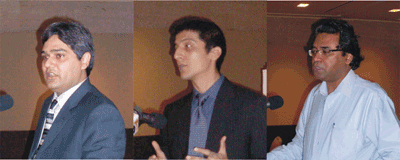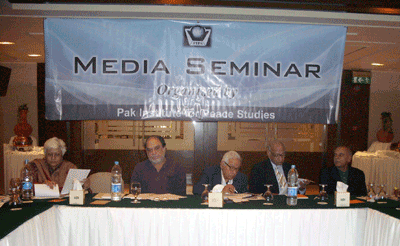Assessing the reporting, approach and impact of militants’ print media in Pakistan
 An analysis of militants’ media in Pakistan evading discussion on the role of the mainstream media will not be a true description of the ‘narrative’ being pursued and promoted by the former. It is really hard to skip over the opinion that has been repeated throughout this seminar that a part of Pakistan’s mainstream media has been manifesting an approach that is very close to the militants’ media, and media barons of Pakistan can’t be excluded from this ‘responsibility’ of creating and promoting an extreme religious or ideological view in the country. Mr. Hussain Naqi, a veteran journalist and human rights activists said this while addressing a seminar on Assessing the Reporting, Approach and Impact of Militants’ Print Media in Pakistan on 18 November 2009 in Lahore. The seminar was organized by the Pak Institute for Peace Studies (PIPS).
An analysis of militants’ media in Pakistan evading discussion on the role of the mainstream media will not be a true description of the ‘narrative’ being pursued and promoted by the former. It is really hard to skip over the opinion that has been repeated throughout this seminar that a part of Pakistan’s mainstream media has been manifesting an approach that is very close to the militants’ media, and media barons of Pakistan can’t be excluded from this ‘responsibility’ of creating and promoting an extreme religious or ideological view in the country. Mr. Hussain Naqi, a veteran journalist and human rights activists said this while addressing a seminar on Assessing the Reporting, Approach and Impact of Militants’ Print Media in Pakistan on 18 November 2009 in Lahore. The seminar was organized by the Pak Institute for Peace Studies (PIPS).
Prominent columnist Hameed Akhtar, renowned intellectual Qazi Javed, senior journalist Khalid Ahmed, human right activist and a leading educationist Dr. Rubina Saigol, and some other renowned journalists including Najam U Din, Wajahat Ali and Wajahat Masood also spoke on the occasion.
Director PIPS Mr. Muhammad Amir Rana, said in his welcome address that the seminar was a part of the PIPS ongoing research-and-analysis and debate on radicalization, extremism and militancy in Pakistan. The features of the militants’ media, particularly its characteristics, themes, reporting approaches and impact on Pakistani society provided a great deal to understand its role and participation in supporting and strengthening the above-mentioned phenomenon. Mr. Safdar Sial, a research analyst at PIPS, presented an abridged version of the PIPS report on militants’ print media.

While speaking at the occasion Qazi Javed noted that the ‘Jihad’ media blossomed during ‘Afghan’ Jihad and has consistently demonised the ‘others’ – other than militants – till now. He expressed his concern while alluding to the PIPS report that the total number of ‘Jihad’ newspapers and magazines rose up to 91 in 1989 and in next year approximately 100 ‘Jihad’ publications were disseminating radical/extreme ideas among Pakistani youth. Hameed Akhter said that Pakistani mainstream media had failed miserably to counter militants’ media. Dr. Rubina Saigol pointed to another dimension of evolution of extremist views saying the textbooks being taught in schools contained harmful content against the non-Muslims and space for alternative thoughts was shrinking. Khalid Ahmed observed that the Pakistani media was under immense pressure and threat from militant outfits. “Militant and extremist outfits do not tolerate criticism. Pakistani media is quite vocal to criticize government for the sake of criticism but we see that it is reluctant to raise a powerful and clear voice against terrorist outfits,” he commented.
It was almost a consensual opinion in the seminar that the mainstream media also shared the responsibility for the current spate of militancy and radicalization in Pakistan as it did not put enough efforts to counter or at least not ‘side with’ the militants’ media. Rather, Pakistani mainstream media had been a source of great confusion among populace regarding the issues of terrorism and extremism. Najam U Din lamented that mainstream media was still reluctant to ‘acknowledge’ the militants especially Taliban as the real threat for Pakistani state and society.

In his concluding remarks, Mr. Hussain Naqi said that PIPS study of militant media was very important in the present situation. “Although the sample of PIPS research is small but its results are fruitful. Such empirical studies would be helpful to understand the different dimensions of a phenomenon that is a source of great concern for all of us,” he concluded.

